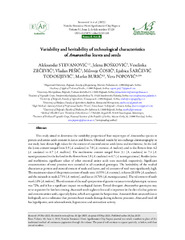Приказ основних података о документу
Variability and heritability of technological characteristics of Amaranthus leaves and seeds
| dc.creator | Stevanovic, Aleksandar | |
| dc.creator | Bošković, Jelena | |
| dc.creator | Zečević, Veselinka | |
| dc.creator | Pešić, Vladan | |
| dc.creator | Ćosić, Milivoje | |
| dc.creator | Šarčević-Todosijević, Ljubica | |
| dc.creator | Burić, Marko | |
| dc.creator | Popović, Vera | |
| dc.date.accessioned | 2023-06-12T12:27:40Z | |
| dc.date.available | 2023-06-12T12:27:40Z | |
| dc.date.issued | 2023 | |
| dc.identifier.issn | 1842-4309 | |
| dc.identifier.uri | http://RIVeC.institut-palanka.rs/handle/123456789/670 | |
| dc.description.abstract | This study aimed to determine the variability properties of four major types of Amaranthus species in protein and amino acids content in leaves and flowers. Obtained results by ion exchange chromatography in our study have shown high values for the content of essential amino acids lysine and methionine. In the leaf, the lysine content ranged from 3.9 (A. caudatus) to 7.0 (A. cruentus; A. moleros), and in the flowers from 4.2 (A. caudatus) to 6.7 (A. molleros). The methionine content ranged from 3.1 (A. caudatus) to 7.4 (A. mantegazzianus) in the leaf and in the flower from 2.9 (A. caudatus) to 6.7 (A. mantegazzianus). Besides lysine and methionine, significant values of other essential amino acids were recorded, respectively. Significant concentrations of total proteins were recorded in all examined genotypes. The heritability of the studied characters as protein and mineral content of seeds and leaves, and oil contents of seed were significantly high. The maximum values of the protein content of seeds were 16.55% (A. cruentus), in leaves 20.10% (A. caudatus), and the minerals in seeds 2.73% (A. moleros), and leaves 18.76% (A. mantegazzianus). The oil content of seeds was 6.16% (A. moleros). The oil content of the seed’s proportion of genetic variance to total phenotypic variance was 72%, and it has a significant impact on ecological factors. Tested divergent Amaranthus genotypes may serve as parents for further crossing. Amaranth seeds is gluten-free and is important in the diet of celiac patients and contains amino acids, especially lysine, which acts against the herpes virus. Amaranth from amaranth leaves biologically active substance that prevents heart muscle damage during ischemic processes. Amaranth seed oil has hypolipemic, anti-atherosclerotic, hypotensive and antioxidant activity. | sr |
| dc.language.iso | en | sr |
| dc.publisher | University of Agricultural Sciences and Veterinary Medicine, Cluj-Napoca | sr |
| dc.publisher | Romanian Academy of Agricultural and Forestry Sciences | sr |
| dc.publisher | Horticulture and Forestry Society from Transylvania | sr |
| dc.relation | info:eu-repo/grantAgreement/MESTD/inst-2020/200032/RS// | sr |
| dc.relation | info:eu-repo/grantAgreement/MESTD/inst-2020/200222/RS// | sr |
| dc.relation | Prizma Project 6770 PALraFES (2023-2027) | sr |
| dc.rights | openAccess | sr |
| dc.rights.uri | https://creativecommons.org/licenses/by/4.0/ | |
| dc.source | Notulae Botanicae Horti Agrobotanici Cluj-Napoca | sr |
| dc.subject | Amaranthus | sr |
| dc.subject | chemical characters | sr |
| dc.subject | protein and amino acid | sr |
| dc.subject | leaves and seeds | sr |
| dc.subject | use in medicine | sr |
| dc.title | Variability and heritability of technological characteristics of Amaranthus leaves and seeds | sr |
| dc.type | article | sr |
| dc.rights.license | BY | sr |
| dc.citation.issue | 2 | |
| dc.citation.spage | 13128 | |
| dc.citation.volume | 51 | |
| dc.identifier.doi | 10.15835/nbha51213128 | |
| dc.identifier.fulltext | http://RIVeC.institut-palanka.rs/bitstream/id/2181/bitstream_2181.pdf | |
| dc.identifier.scopus | 2-s2.0-85163139023 | |
| dc.type.version | publishedVersion | sr |


